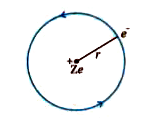Using the formula for the radius of nth orbit rn=n2h2ε0πmZe2 derive an expression for the total energy of electron in nth Bohr's orbit.Solution in Gujrati
The atomic model of Bohr is shown in the figure.

Let mass of electron m, charge e, linear speed in nth orbit vn and orbital radius rn.
Positive charge on nucleus Ze, where Z = atomic number of element.
The necessary centripetal force is provided by Colombian attractive force between an electron and the positive charge of the nucleus.
∴mv2nrn=(Ze)(e)4πε0r2n
∴12mv2n=Ze28πε0rn
∴ Kinetic energy K=Ze28πε0rn ....(1)
And potential energy.
U=kq1q2rn
∴U=−(Ze)(e)4πε0rn=−Ze24πε0rn....(2)
⇒ Total energy of electron,
En = kinetic energy K + potential energy
=Ze28πε0rn−Ze24πε0rn[ ∴ from equation (1) and (2)]
=−Ze28πε0rn
Now putting rn=n2h2ε0πmZe2
En=−Ze28πε0×πmZe3n2h2ε0
∴En=mZ2e48n2h2ε20 ...(3)
∴En∝−Z2n2[ ∴ All other terms are contant]
For hydrogen atom Z=1.
En=me48n2h2ε20 ...(4)
which is the total energy of electron in the nth orbit of atom. It is assumed that deriving this formula the electronic orbits are circular.
Putting the accepted value of m, e, h and €, in equation (4),
En=2.18×10−18n2J
but 1.6×10−19KJ=1eV
∴En=−2.18×10−18n2×1.6×10−19eV
=−13.6n2eV[whereme48h2ε20=3.6eV]
The negative sign of the total energy indicates that electron is bound with nucleus.
Topper's Solved these Questions
- ATOMSBOOK - KUMAR PRAKASHANCHAPTER - ATOMSEXERCISE - TRY YOURSELF
43 Videos
- ATOMSBOOK - KUMAR PRAKASHANCHAPTER - ATOMSEXERCISE - SECTION-B (NUMERICALS) (Numerical From Textual Illustrations)
9 Videos
- ALTERNATING CURRENTS BOOK - KUMAR PRAKASHANCHAPTER - ALTERNATING CURRENTS EXERCISE - SECTION-D MCQs (COMPETITIVE EXAMS)
64 Videos
- BOARD'S QUESTION PAPER MARCH-2020 BOOK - KUMAR PRAKASHANCHAPTER - BOARD'S QUESTION PAPER MARCH-2020 EXERCISE - PART-B SECTION -C
4 Videos
Similar Questions
Why atoms are electrical neutral ?
View SolutionIn the Rutherford’s nuclear model of the atom, the nucleus (radius about 10–15 m) is analogous to the sun about which the electron move in orbit (radius ≈10–10 m) like the earth orbits around the sun. If the dimensions of the solar system had the same proportions as those of the atom, would the earth be closer to or farther away from the sun than actually it is? The radius of earth’s orbit is about 1.5×1011m. The radius of sun is taken as 7×108m.
View SolutionPower factor of AC series circuit having resistance R and inductor L having angular frequency ω is ……..
View SolutionDerive an expression for current I passing through an AC circuit containing only inductor L. Draw a Phasor diagram and graph of v and I versus ωt. Explain instantaneous power and the average power.
View SolutionIn the Bohr model of the atom (i) the radius of the n^(th) orbit is proportional to n^(2) (ii) the total energy of the electron in n^(th) orbit is inversely proportional to n (iii) the angular momentum of the electron in an orbit is an integral multiple of h//2 pi (iv) the magnitude of the P.E. of the electron in an orbit is gt its K.E.
View SolutionNth level of Li2+ has the same energy as the ground state energy of the hydrogen atom. If rN and r1 be the radius of the Nth Bohr orbit of Li2+ and first orbit radius of H atom respectively, then the ratio rNr1 is
View SolutionThe energy of an electron in the nth Bohr orbit of hydrogen atom is
View Solutionबोहर के परमाणविक सिद्धांत के अभिगर्हितों को लिखिए। सिद्ध कीजिए की इलेक्ट्रॉन की nवीं कक्षा की त्रिज्या (rn),n2 के अनुक्रमानुपाती होती है।
View SolutionUsing Bohr's postulates of the atomic model, derive the expression for radius of n-th electron orbit. Hence obtain the expression for Bohr's radius.
View SolutionGiven that r_(n-1)+r_(n)=r_(n+1) where r represents Bohr's orbit for (n-1)^("th"),n^("th") and (n+1)^("th") orbit, then n is
View SolutionState Bohr's postulates. Using these postulates, derive an expression for total energy of an electron in the n^("th") orbit of an atom. What does negative of this energy signify ?
View SolutionThe energy associated with Bohr's orbit in the hydrogen atom is given by the expression, En=−13.6n2eV. the energy in eV
associated with the orbit having a radius 9 r1 is (r1 is the radius of the first orbit )
View SolutionWrite the expression for total energy of an electron in nth orbit.
View SolutionWrite the expression for the radius of nth orbit of the hydrogenic atoms and give the meanings of the symbols used.
View SolutionUsing Bohr's postulates of the atomic model, derive the expression for radius of th electron orbit. Thus, obtain the expression of Bohr's radius.
View Solution
